The Fogging Tester Market is estimated to be valued at USD 1.9 billion in 2025 and is projected to reach USD 3.4 billion by 2035, registering a compound annual growth rate (CAGR) of 5.8% over the forecast period.

The fogging tester market is expanding steadily due to increasing regulatory requirements and quality standards in industries concerned with material emissions and optical clarity. There is a growing emphasis on ensuring that automotive interiors and plastics meet strict fogging limits to enhance safety and comfort. Advancements in testing technologies and equipment have improved the precision and repeatability of fogging tests, enabling manufacturers to comply with evolving standards more efficiently.
The rise in automotive production and heightened focus on vehicle interior quality have further stimulated demand for fogging testers. Additionally, regulatory bodies in key markets have introduced stricter emission norms, increasing the need for reliable and accurate fogging measurements.
With ongoing innovations in test methodologies and expanding applications beyond automotive, the market outlook remains promising. Segmental growth is anticipated to be driven by the Gloss Method for data type, Durometer as the leading equipment type, and automotive testing as the primary application.
The market is segmented by Data Type, Equipment Type, and Application and region. By Data Type, the market is divided into Gloss Method, Gravimetric Method, and Haze Method. In terms of Equipment Type, the market is classified into Durometer, Speed & Length Meter, Moisture Meter, Material Thickness Gauge, and Tension Meter.
Based on Application, the market is segmented into Automotive Testing, Plastics Testing, Rubber Testing, and Aerospace Testing. Regionally, the market is classified into North America, Latin America, Western Europe, Eastern Europe, Balkan & Baltic Countries, Russia & Belarus, Central Asia, East Asia, South Asia & Pacific, and the Middle East & Africa.
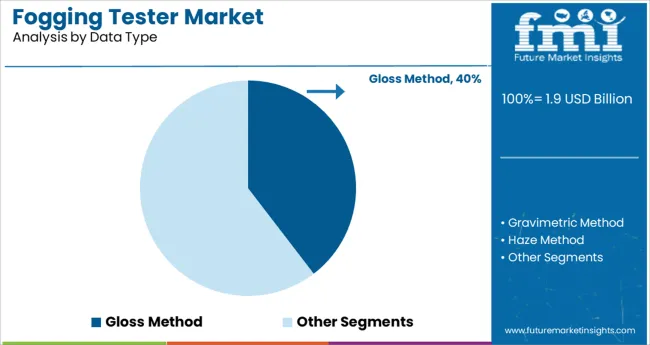
The Gloss Method segment is expected to account for 39.6% of the fogging tester market revenue in 2025, leading the data type category. This method has gained traction due to its ability to quantitatively measure the degree of fogging on surfaces, providing a reliable indicator of material performance. Manufacturers have preferred the gloss method for its sensitivity and ease of use in detecting early fogging effects.
Its applicability across various plastic and polymer materials used in automotive interiors has made it a standard in quality control processes. The method’s compatibility with automated testing setups has also supported its growth.
As automotive manufacturers continue to prioritize interior material safety and aesthetics, the Gloss Method segment is expected to maintain its prominence.

The Durometer segment is projected to contribute 35.2% of the fogging tester market revenue in 2025, securing its position as the top equipment type. Durometers have been widely adopted for measuring the hardness of materials that influence fogging characteristics. Their precise measurement capabilities allow manufacturers to assess the durability and performance of polymers and plastics used in interior components.
The portability and user-friendly design of modern durometers have made them popular for both laboratory and on-site testing. Industry trends indicate that the demand for durometer-based testing equipment is growing due to its integral role in product development and quality assurance.
As manufacturers aim to enhance material properties to reduce fogging, the Durometer segment is poised for continued growth.
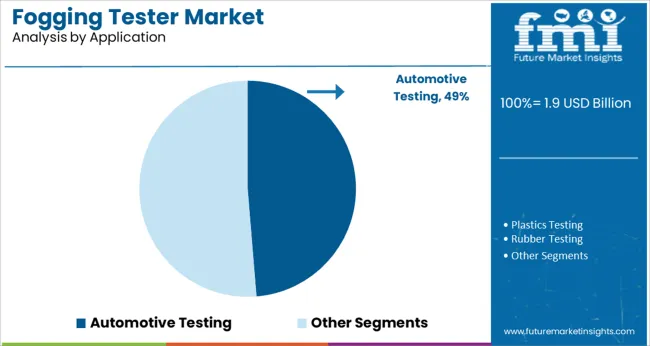
The Automotive Testing segment is projected to hold 48.7% of the fogging tester market revenue in 2025, establishing itself as the leading application area. Growth in this segment is attributed to the automotive industry's stringent regulations on interior air quality and material emissions. Vehicle manufacturers have been focusing on reducing fogging on windshields and interior surfaces to improve driver visibility and passenger comfort.
Increased consumer demand for higher quality interiors has driven investments in testing and certification of materials. The sector's expansion is further supported by the rise in electric and autonomous vehicles, which demand higher standards of cabin environment quality.
As regulatory frameworks become more rigorous and consumer expectations rise, the Automotive Testing segment is expected to sustain its market dominance.
Rapid production of automotive and aerospace vehicles and growing focus towards improving passenger safety are some of the major factors driving growth in the global fogging tester market.
Fogging testers have become highly sought-after testing equipment used across automotive and aerospace industries for measuring fogging characteristics of vehicle interior materials like fabrics, polymers, leathers, etc. These fogging testers provide accurate and reliable results, thereby helping automotive manufacturers to effectively enhance passenger safety.
Over the years, rising production and sales of automotives has bolstered the demand for fogging testers and the trend is likely to continue during the forecast period. According to the International Organization of Motor Vehicle Manufacturers, total global vehicle production surpassed 1.8 million in 2024 and the number is expected to further surge in the future. This will continue to create opportunities for fogging tester manufacturers.
Similarly, rise in the number of accidents worldwide coupled with increasing need for enhancing passengers' safety and introduction of stringent quality control regulations is expected to fuel the growth of the fogging testers market during the forecast period.
In addition to this, advancements in fogging testers will further expand the global fogging tester market size during the forthcoming period. Leading manufacturers are constantly innovating for developing advanced fogging testers with higher efficiencies.
Despite a positive demand outlook, there are certain factors that are limiting the growth of fogging tester market. Some of these factors include high cost of fogging testers, dearth of skilled labor, and low penetration of product across lower economies.
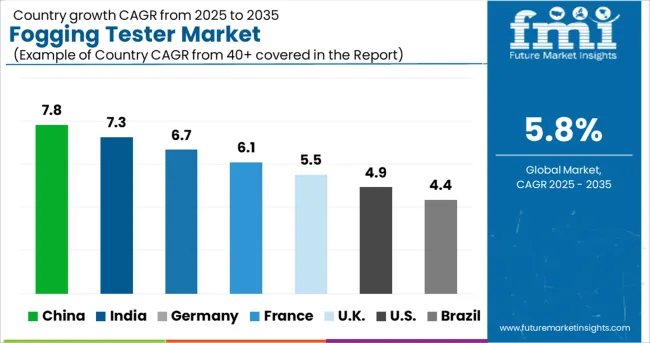
According to Future Market Insights, Asia Pacific fogging tester market is poised to exhibit strong growth during the forecast period between 2025 and 2035. Growth in Asia Pacific market is driven by rapid production of vehicles, presence of stringent government regulations, and growing popularity of fogging tests for improving passenger safety.
Majority of the fogging tester sales remain concentrated in China due to booming automotive industry and presence of some of the world’s leading vehicle manufacturing giants. The total vehicle production in China reached over 1.8 million in 2024 as per the International Organization of Motor Vehicle Manufacturers. This sharp rise in automotive production is creating demand for testing equipment like fogging testers
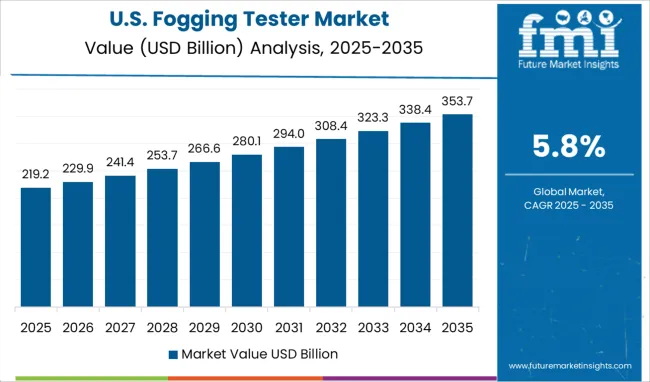
Demand for fogging testers is expected to grow at a considerable pace across North America during the forecast, owing to the rapid expansion of automotive industry, rising adoption of fog testing technologies, strong presence of leading fogging testers manufacturers, and introduction of stringent regulations pertaining to vehicle and passenger safety.
The fogging tester market in North America is mainly dominated by the USA due to rapid surge in automotive and aerospace vehicles production and increase in the usage of interior designs and materials for improving the appearance of vehicles.
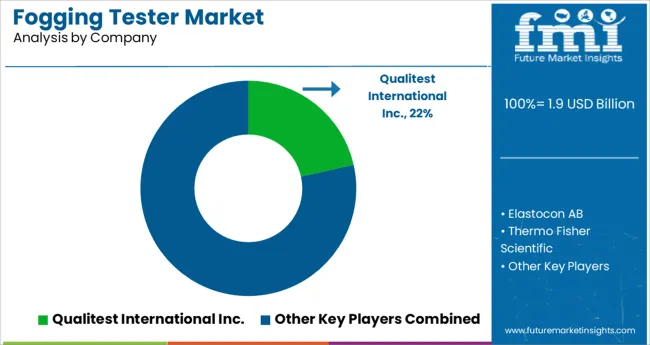
Some of the leading manufacturers of fogging tester include Elastocon AB, Thermo Fisher Scientific, SDL Atlas, Labthink International, Artec Testnology, Qualitest International Inc., Asian Test Equipments, Soraco srl, Barkey, SK Equipments, and Jinan XingHua Instruments among others.
These leading players have adopted various organic and inorganic strategies such as new product launches, partnerships, acquisitions, mergers, collaborations, etc. to expand their global footprint and gain a competitive edge in the market.
| Report Attribute | Details |
|---|---|
| Growth Rate | CAGR of 5.8% from 2025 to 2035 |
| Projected Market Size (2035) | USD 3.4 billion |
| Base Year for Estimation | 2024 |
| Historical Data | 2020 to 2024 |
| Forecast Period | 2025 to 2035 |
| Quantitative Units | Revenue in million and CAGR from 2025 to 2035 |
| Report Coverage | Revenue Forecast, Volume Forecast, Company Ranking, Competitive Landscape, Growth Factors, Trends and Pricing Analysis |
| Segments Covered | Data Type, Equipment Type, Application, Region |
| Regions Covered | North America; Latin America; Western Europe; Eastern Europe; APEJ; Japan; Middle East and Africa |
| Key Countries Profiled |
USA, Canada, Brazil, Argentina, Germany, UK, France, Spain, Italy, Nordics, BENELUX, Australia & New Zealand, China, India, ASEAN, GCC, South Africa |
| Key Companies Profiled | Elastocon AB; Thermo Fisher Scientific; SDL Atlas; Labthink International; Artec Testnology; Qualitest International Inc.; Asian Test Equipments; Soraco srl; Barkey; SK Equipments; Jinan XingHua Instruments |
| Customization | Available Upon Request |
The global fogging tester market is estimated to be valued at USD 1.9 billion in 2025.
It is projected to reach USD 3.4 billion by 2035.
The market is expected to grow at a 5.8% CAGR between 2025 and 2035.
The key product types are gloss method, gravimetric method and haze method.
durometer segment is expected to dominate with a 35.2% industry share in 2025.






Full Research Suite comprises of:
Market outlook & trends analysis
Interviews & case studies
Strategic recommendations
Vendor profiles & capabilities analysis
5-year forecasts
8 regions and 60+ country-level data splits
Market segment data splits
12 months of continuous data updates
DELIVERED AS:
PDF EXCEL ONLINE
Engine Fogging Oil Market Size and Share Forecast Outlook 2025 to 2035
5G Tester Market Growth – Trends & Forecast 2019-2027
RF Tester Market Growth – Trends & Forecast 2019-2027
LAN tester Market Size and Share Forecast Outlook 2025 to 2035
SCC Tester Market Size and Share Forecast Outlook 2025 to 2035
LED Tester Market
DSL Tester Market Growth – Trends & Forecast 2019-2027
Drug Tester Market Size and Share Forecast Outlook 2025 to 2035
Gold Tester Market Size and Share Forecast Outlook 2025 to 2035
Tube Tester Market Size and Share Forecast Outlook 2025 to 2035
CCTV Tester Market Size and Share Forecast Outlook 2025 to 2035
RFID Tester Market Size and Share Forecast Outlook 2025 to 2035
Pump Testers Market Size and Share Forecast Outlook 2025 to 2035
Food Tester Market Size and Share Forecast Outlook 2025 to 2035
Paper Tester Market Size and Share Forecast Outlook 2025 to 2035
Scuff Tester Market Size and Share Forecast Outlook 2025 to 2035
Paint Tester Market Size and Share Forecast Outlook 2025 to 2035
Hipot Tester Market Analysis – Share, Size, and Forecast 2025 to 2035
Mining Tester Market Size and Share Forecast Outlook 2025 to 2035
Torque Testers Market

Thank you!
You will receive an email from our Business Development Manager. Please be sure to check your SPAM/JUNK folder too.
Chat With
MaRIA